When I was a child a snack that my father would sometimes eat was bread and dripping.
Dripping was the fat left in the pan after roasting (usually) either beef or mutton (1). After the roast was removed from the pan the “juices” were allowed to settle and any excess oil rose to the surface. This fat is clear at first but as the contents of the roasting pan brown the oil takes on an amber hue which darkens more the longer it cooks.
- Sheep meat is one of the most commonly consumed meats in the world. The meat is categorised by age and generally divided into lamb, from animals one year old or less, hogget, between 1 and 2 years old, and mutton from older sheep.
Pork fat is also commonly used (and will be our focus today).
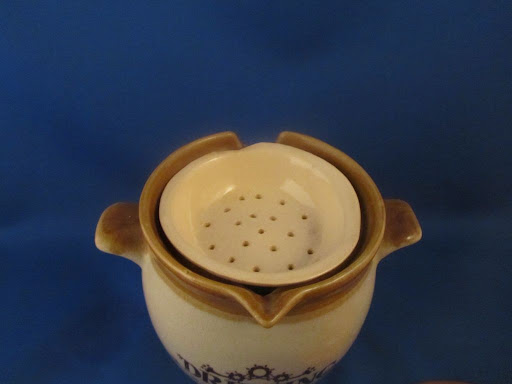
The oil from my fathers roasting was carefully poured out into a container like the one shown above where it would separate the solid bits (these become important later) and the oil would cool and semi solidify into a soft pale brown fat. This fat separated into layers with the lighter rising to the surface while a darker, more flavoursome layer, settled to the bottom.
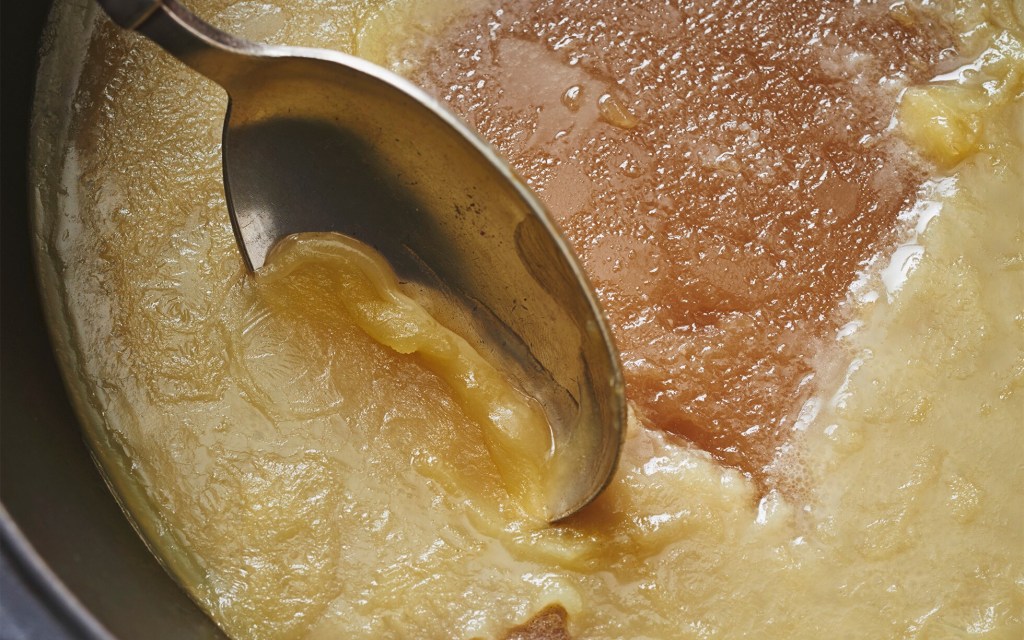
It was this dark layer that my father slathered on fresh crusty bread and consumed with gusto.

Bread and dripping plays a role in the history of Australia. Australia is a country that rose to prominence “off the sheeps back” both pre and post WWII and in some ways still does. Australian wool (amongst the finest in the World) (1) and Australian sheep (particularly live exports) still produce huge profits for Australia. The history of sheep and its effects on the country are a strong part of our ongoing history and much has been written of it
- Australia is one of the world’s largest wool producers, producing around 25 per cent of greasy wool sold on the world market. The value of Australian wool exports in 2021-22 was $3.592 billion – https://www.agriculture.gov.au/agriculture-land/farm-food-drought/meat-wool-dairy/wool#:~:text=Australia%20is%20one%20of%20the,as%20among%20the%20world’s%20best.
- Australian sheep meat export volumes are expected to reach a record 557 thousand tonnes (shipped weight) in 2023–24 (up by 11%) – https://www.agriculture.gov.au/abares/research-topics/agricultural-outlook/sheep-meat#:~:text=Australian%20sheep%20meat%20export%20volumes,%25)%20reflecting%20strong%20production%20volumes. : In 2023, live sheep exports by sea lifted 22% or 107,191 head to 593,514. – https://www.mla.com.au/news-and-events/industry-news/a-summary-of-2023-australian-live-exports/

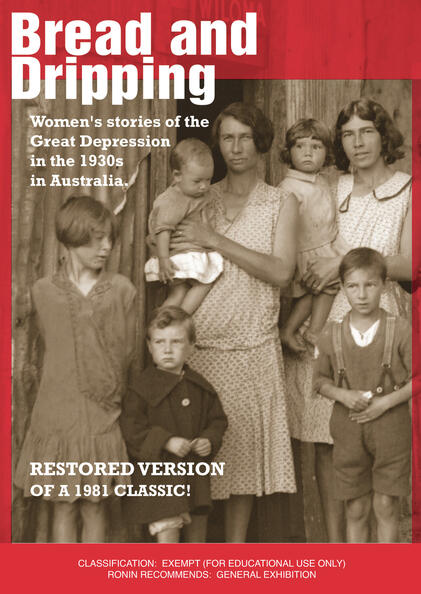
In the book “Bread and Dripping”, four women recount their lives during the bleak years of the economic depression in Australia during the 1930s (1). Tibby Whalan, Eileen Pittman, Beryl Armstrong and Mary Wright describe their struggles to survive and maintain families when faced with unemployment, evictions and hardship. Bread and Dripping provides a window into the lives of both Indigenous and non-Indigenous women as they faced the challenges of this major economic and social crisis. The book makes extensive use of archival footage and photographs from the 1930s to present a fascinating insight into the lives of women in Australia. The title, Bread and Dripping, refers to a meal of leftover bread soaked in fat and eaten when no other food was available. It was a food of the poor and is remembered somewhat fondly in these days.
- Australia suffered badly during the period of the Great Depression of the 1930s. The Depression began with the Wall Street Crash of 1929 and rapidly spread worldwide. As in other nations, Australia suffered years of high unemployment, poverty, low profits, deflation, plunging incomes, and lost opportunities for economic growth and personal advancement. The Australian economy and foreign policy largely rested upon its place as a primary producer within the British Empire, and Australia’s important export industries, particularly primary products such as wool and wheat, suffered significantly from the collapse in international demand.


Dripping is fat rendered at low temperature to separate it from connective tissue and meat. Warm, it’s a clear liquid and at room temperature it solidifies. Dripping was a traditional medium for frying fish and chips, Although dripping can be made from any beef fat, in her book, Forgotten Skills of Cooking, Darina Allen says “the best beef dripping is made from the fat that encases the beef kidney”. This dripping, technically known as suet, keeps in the fridge for months.
This “dripping” has a different name in Mexico and is a valuable cooking ingredient. You might know this particular product by the English name (pork) “lard” or the Spanish “manteca” (1). Manteca is used widely in Mexican cookery for nearly everything (2). Aside from its ubiquitous use in frying (from frijoles refritos to carnitas) it is used to make tamales fluffy and full bodied, to make pastry delicate and crispy, and to add richness and depth to your moles and cooked salsas. What we’ll be looking at is something (the “solid bits” I mentioned earlier) primarily produced from pork fat and this is called asiento.
- the word mantequilla is sometimes used but for our purposes manteca is lard and mantequilla is butter.
- after cilantro it is probably the most widely used imported ingredient
Now, when you come across lard in your local supermarket you are likely to run into this.
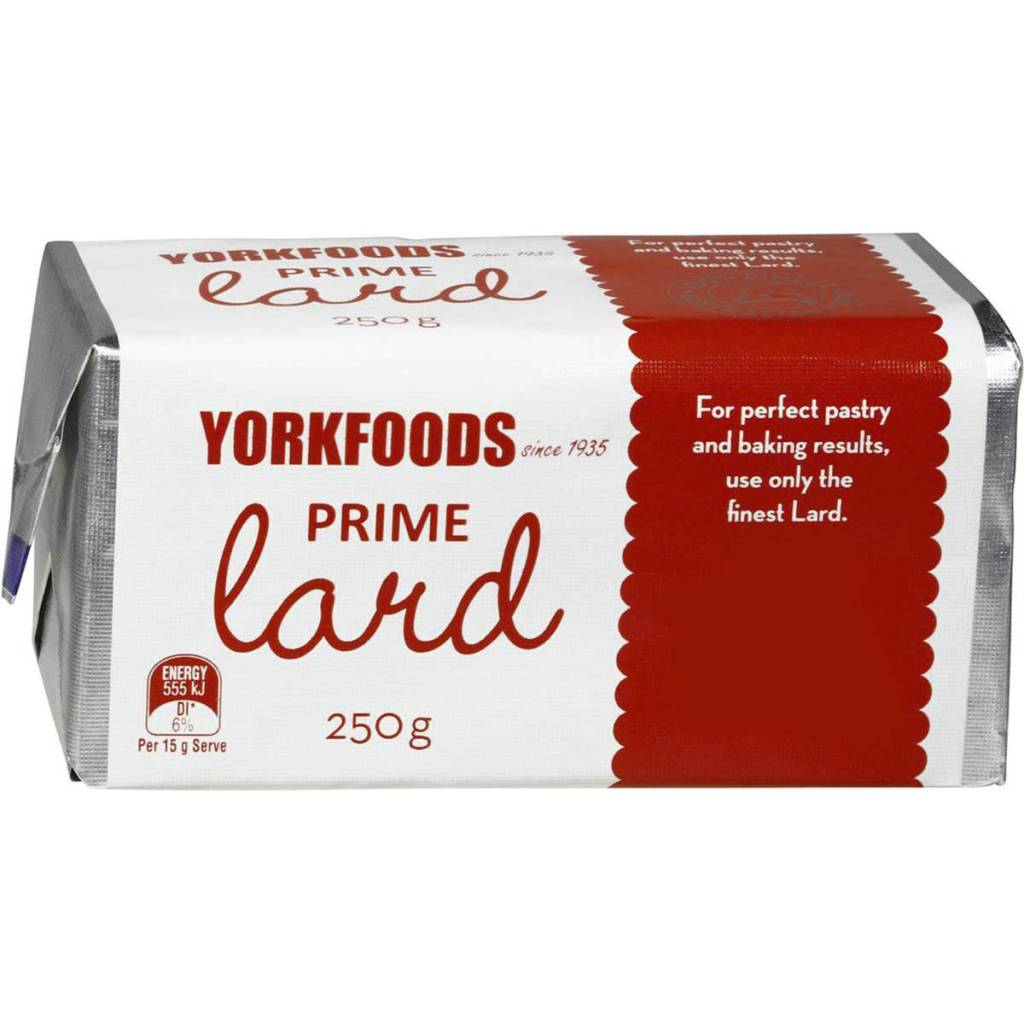

This block of snowy white wonder has been purified into a gloriously clean and completely bland product and really doesn’t resemble what a Mexican would call manteca at all. Now, to be fair, when you are rendering (1) your own pig fat into lard (2) it will, over the course of the rendering, produce 3 different products. The first is a clear white liquid which , if filtered, will harden into the white block of goodness above; the second is a clear amber coloured liquid and the third is the remaining oil into which any particles of non-fat in the lard has cooked and browned into a sediment which will settle to the bottom of the liquid. This last product is our asiento. This is very much like the dripping my father ate.
- “Rendered” fat means that the raw pig fat is heated to a melting point (around 100 – 120°F : 38 – 48 °C) then cooked for a short period of time to filter the fat from any other natural meaty substances that remain after butchering
- There are three main sources of lard: Leaf lard: obtained from the fat deposits surrounding the pig’s kidneys. It is the highest quality lard with a melting range of 30-40 °C (86-104 °F). Back fat lard: obtained from the back skin and flesh and has a melting range of 43-48 °C (109-118 °F) and Caul lard: the lowest quality lard obtained from the surroundings of the digestive system, in particular the small intestine. It’s melting range is 36-45 °C (97-113 °F).
Now to be perfectly clear, asiento and manteca are quite different. Your Mexican lard might look like the “home-made” store bought product below. It consists of the two “coarser” grades of lard and is quite the distance away from being the block of purified blanco shown above.
BUT……

One thing the manteca above is missing though is the asiento.
So what is asiento?
Asiento (also aciento)
Etymology
Asiento (seat)
Poso o conjunto de partículas sólidas que se depositan en el fondo de un recipiente.
Sludge or set of solid particles that are deposited at the bottom of a container.
m. poso (sedimento). dregs (sediment) : Sediment of the liquid contained in a vessel .
asentar (settle)
Dicho de un líquido: posarse (depositarse en el fondo sus partículas sólidas). Said of a liquid: to posarse (perch, settle, alight, sit) (to deposit its solid particles at the bottom).
Now we’re getting somewhere. We are at the “solid particles deposited at the bottom”. These are the solid bits of pork – everything that wasn’t fat – that have now cooked to a delightfully delicious golden brown

The asiento looks good by itself and quite frankly you can emulate my fathers bread and dripping “estilo mexicana” by simply making tacos de asiento.

According to Oaxacan lore, communities in the state began to produce asiento after the Spanish conquest, as the “peninsulares” (1) brought with them an increase in the consumption of animal products.
- Peninsulares were the Spanish born Spaniards who found themselves in the New World. Criollos were Spaniards born of Spanish parents but they were born in the colonies of the New World. The penisulares considered themselves to be more Spanish than the criollos and as such considered the criollos to be far inferior than themselves. Until 1760, the Spanish colonies were ruled under laws designed by the Spanish Habsburgs (the Catholic Monarchy, in the period from 1516 to 1700 when it was ruled by kings from the House of Habsburg). They gave the American provinces great independence. The situation changed with the Bourbon Reforms during the reign of Charles III. Spain needed to get more money from its colonies for the European and global wars it was fighting so it could maintain the Spanish Empire. The Crown made the Penisulares more important, and they took over many administrative offices which had been filled by Criollos. At the same time, reforms by the Catholic Church reduced the roles and privileges of the lower ranks of the clergy, who were mostly Criollos. By the 19th century, this unfair policy of the Spanish Crown and the examples of the American and French revolutions, led the Criollos to rebel against the Peninsulares. With increasing support of the other castes, they started to fight Spain in for independence (1809–1826). The casta system was complicated in the New World. The peninsulares were at the top, followed by the criollos and then the mestizos (these were mixed Spanish and indigenous Mexicans or “indios”) after this it involved many gradations according to skin colour which included pardos (spanish/indio/african), mulattos (indio/african), zambos (spanish/african), mariscos (mulatto/spanish), tresalvos (morisco/spanish). Additional categories in the Casta system included Lobos (from a Lobo and Indian parentage), Chinos (from Amerindian and African ancestry), and Coyotes (from Mestizo and Indigenous parents). There were even more nuanced classifications like Zambaigos, Torna Atrases, Albinos, and Cambujos, each signifying different combinations of racial heritage.

The casta system was horribly racist and elements of it exist to this day

The asiento above comes with several health warnings.
- Excess calories
- Excess sodium
- Excess saturated fats
The RDA (recommended daily allowance) for sodium intake is less than 5g (5000mg). An adult male needs around 1 to 2g of salt (460 to 920mg sodium) per day to function. (Mente etal 2021) Pork by itself is relatively low in sodium (around 62mg in a 100g serve) but once it is seasoned or preserved (ham/salami) it contains much more (as much as 1800mg per 100g). Asiento (depending on its source) might contain between 105 – 270mg of sodium per 100g. So if you are rendering your own lard from fresh, unpreserved pork fat it is not overly high in sodium.
Sodium intake above 2,000mg per day is associated with high blood pressure, which is a risk factor for kidney disease and cardiovascular disease (such as heart disease and stroke).
So, I’m not exactly sure what they’ve done with the little tub of asiento shown above which requires it to have an Exceso Sodio warning because generally this would not be the case.
Calories and calories from fat.
Pork, in general, has half, or thereabouts, of its caloric content come from fat. This decreases depending on the dish it is cooked in, and manteca itself is almost 100 percent of its calories being derived from fat (which is not unusual if you consider its make up)
- Cerdo (Pork loin) Serving size (85grams)
Calories 202 : calories from Fat 108
- Costilla de puerco Serving size (30 grams) (pork ribs – more fatty than the loin – this is demonstrated by the much smaller serving size than the loin – less than half – and the much higher caloric content)
Calories 216 : calories from fat 144
- Chicharrones de puerco Serving Size (14grams) (essentially just skin – this is interesting as it has less calories per gram than the fatty costillas)
Calories 80 : Calories from Fat 36
- Puerco guisado (stewed pork with tomatoes and chilies) (1 cup)
Calories 226 : Calories from Fat 119.7
- Homemade Carne De Puerco Con Chile Rojo (1 cup)
Calories 193 : Calories from fat 90
- Rendered Pork Fat (Manteca De Puerco) Serving Size (14g) (almost gram for gram pure fat)
Calories 110 : Calories from Fat 108
Nutritional Content
The controversy over dietary lipids (fats) and their consumption was essentially born in the 1950’s with the hypothesis proposed by Ancel Keys and his “Seven Countries Study” which purportedly demonstrated that a diet high in fat consumption was unhealthy and that it led to a sequence of relationships in which a fatty diet elevates serum cholesterol levels, leading to atherosclerosis and myocardial infarction. His theory shifted from the total fat consumed in the diet to the more nuanced idea that saturated fats should be replaced by polyunsaturated fats and the benefits of replacing animal fats with vegetable fats were advocated. This study led to the proposition that the “Mediterranean” diet was the most healthful diet and this diet has been pushed ever since then. The major issue with the Mediterranean diet is its insistence on an increased consumption of carbohydrates which dietarily speaking is more damaging to the health and is the cause of a lot of issues such as obesity and diabetes.(Forouhi etal 2018)
Ancels theories however were flawed by his deliberate cherry picking of data and he purposefully left out certain information such as areas that consumed little dietary fats but had high incidences of cardiovascular disease and areas that had a diet high in the consumption of animal fats but had very little cardiovascular disease. His theories then shifted from fat as being the enemy to that of cholesterol (particularly LDL) as being the enemy. Both of these are inherently flawed. Fat in and of itself is not inherently unhealthy. Excessive consumption of it (or anything really) is where health issues can arise.
The links between fat consumption and the risk of cardiovascular disease have been among the most controversial issues in public health and medical literature is still full of articles arguing opposing positions. For example, in 2017, the American Heart Association Presidential Advisory strongly endorsed that “lowering intake of saturated fat and replacing it with unsaturated fats, especially polyunsaturated fats, will lower the incidence of CVD”(Sacks etal 2017). Three months later, the 18-country observational Prospective Rural Urban Epidemiology (PURE) Study concluded much the opposite: “Total fat and types of fat were not associated with cardiovascular disease, myocardial infarction, or cardiovascular disease mortality” (Dehghan etal 2017). Dehghans study (2017) is a much more definitive work than that of Key as it covers 18 countries and refutes Keys’ findings by noting that “High carbohydrate intake was associated with higher risk of total mortality, whereas total fat and individual types of fat were related to lower total mortality. Total fat and types of fat were not associated with cardiovascular disease, myocardial infarction, or cardiovascular disease mortality, whereas saturated fat had an inverse association with stroke” and that as a result “Global dietary guidelines should be reconsidered in light of these findings.”
Trans fats however are definitively linked to the diseases being discussed and there is a general consensus that these fats should not be consumed in any great quantity (or even at all).

The nutrition of lard is generally thought of as being an unhealthy fat in comparison to butter, margarine or vegetable oils. From a naturopathic point of view both lard and butter are more healthy than margarine and margarine should not be eaten at all. Margarine is made from vegetable oils which have been hydrogenated (1). This produces what is known as a “trans fat”.
- Hydrogenation is a process where manufacturers add hydrogen to a liquid fat, such as vegetable oil, to turn it into a solid fat at room temperature.

These trans fatty acids have been implicated in a range of negative health effects from cardiovascular disease to stroke (Pipoyan etal 2021). They do this via the raising of LDL and the lowering of HDL (relatively speaking). LDL (1) or low density lipoprotein is considered to be “bad” cholesterol and HDL (high density lipoprotein) is considered to be a “good” cholesterol (2). Now neither of these things is a cholesterol but simply a mechanism for carrying cholesterol (which is not water soluble) in an aqueous environment (i.e. the blood). LDL is considered “bad” as it carries cholesterol into the body where it is deposited. HDL is considered “good” as it carries cholesterol to the liver where it is processed for excretion from the body. Now cholesterol in and of itself is not bad and is a necessary component of the human body and important for the production of hormones such as testosterone. If the body does not receive enough dietary cholesterol it can and will produce its own. Too much cholesterol will raise the risks of various health conditions but this does not necessarily mean that high blood levels of cholesterol will cause heart attacks (Pirahanchi etal 2023). Inflammation within the body makes cholesterol more dangerous than high cholesterol levels alone and this is relevant more to high levels of cholesterol deposited within the body rather than high blood levels of cholesterol. There is much controversy here as to lower high blood levels of cholesterol (which I’ve mentioned are not as damaging as deposited cholesterol) a type of drug called a HMG-Coenzyme A reductase inhibitor (or Statin) is used medicinally to reduce these circulating levels of cholesterol (which they do quite effectively) but they themselves are a potential danger as they interfere with various processes that are extremely important and can cause issues with muscle, liver and brain function.
- Cholesterol is not water soluble. Lipoproteins are used to transport cholesterol in an aqueous environment i.e. our blood
- Cholesterol is the principal sterol (3) of all higher animals, distributed in body tissues, especially the brain and spinal cord, and in animal fats and oils. Cholesterol is biosynthesized by all animal cells and is an essential structural component of animal cell membranes. It is a vital constituent for normal functioning of the nervous system, plays an important role both during the developmental stage and in adult life and the brain contains about 25% of the whole body’s cholesterol and is considered as a cholesterol-rich organ
- Sterols are the third major class of membrane lipids. Cholesterol is the major sterol in animal plasma membranes. Phytosterols are phytosteroids, similar to cholesterol, that serve as structural components of biological membranes of plants. They encompass plant sterols and stanols. More than 250 sterols and related compounds have been identified.
Another potential treatment for high cholesterol levels (and a more natural one than Statin drugs) is that of (are those of) plant sterols and stanols. Plant sterols and stanols are naturally occurring substances found in various foods like fruit and vegetables, vegetable oils and nuts and grains. They are however not found in quantities great enough to be medicinal so they need to be extracted and concentrated. These sterols have a chemical structure similar to that of cholesterol and can partly block the absorption of cholesterol from the gut. This results in a reduction in blood LDL-cholesterol. Studies (although not all – and not all studies have shown these benefits either) show that the consumption of between 1500 and 3000mg (1.5 – 3 grams) of plant setrols per day (including “healthy” diet and lifestyle changes) can lower LDL levels by between 7 to 12.5% after 3 weeks of use. Other research also demonstrated that plant sterols have a modest triglyceride-lowering effect. I have included a number of studies in the References if you wish to explore this further.

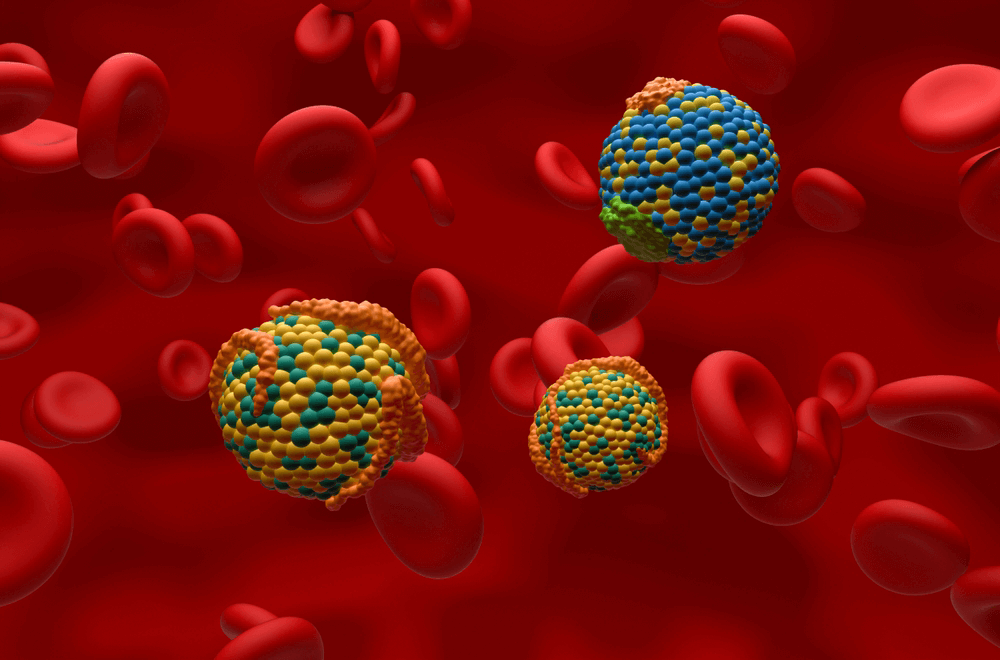
This is a very basic explanation of cholesterol, fats and human health. I’m not going into the deeper issues involved but merely wish to point out that lard and butter are very similar to each other (nutritionally speaking) and that both are healthier for you than margarine.
Asiento as a cooking ingredient.
Asiento is a basic ingredient in two of Oaxaca’s best known dishes, memelas and tlayudas.
Tlayudas (1) consist of a large, thin, crunchy, partially fried or toasted tortilla covered with a spread of refried beans, asiento, lettuce or cabbage, radishes, tomato and avocado, as well as cecina, chorizo, tasajo and salsa.
- in the CDMX a tlayuda might also be called a doradito (and in Toluca, a tlayuda – which is something different again in Mexico City)
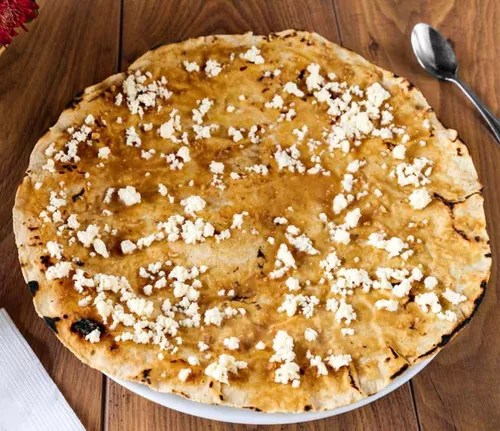
(bread and dripping style)

Chepiche is a uniquely flavoured and scented herb from the Porophyllum species which is a primary focus of my Blog. Check out this quelite here Quelite : Chepiche/Pipicha : Porophyllum tagetoides. This Post also contains information on how the consumption of chepiche with fatty foods offers a mitigating (if not outright medicinal) effect on the negative dietary effects lipids may have on health. Chepiche should also be eaten raw for this purpose (Arias-Rico etal 2020) (and if you need to know what quelites are then go here……Quelites : Quilitl)
Memelas or memelitas are handmade, thick corn tortillas toasted on a hot comal, spread with asiento, black bean sauce and queso fresco.



Vitamina T
Vitamin T is a nutritional element little known to nutritionists outside of Mesoamerica. It is based primarily on corn masa and its many iterations. All are somewhat similar, but completely different (even if they are the same thing). ????
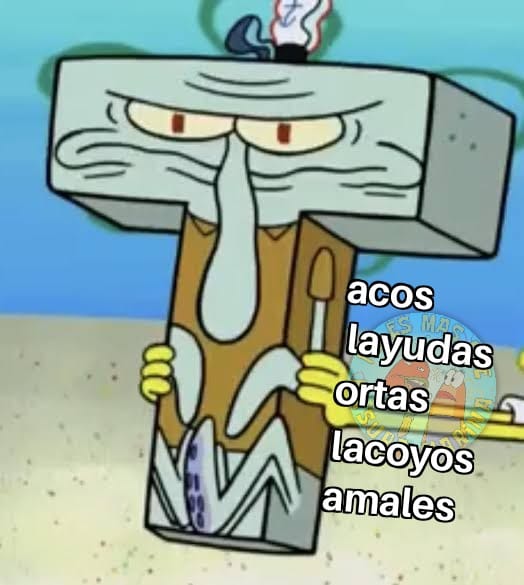
These might also be included in the category of Mexican snacking foods called antojitos.
Antojitos is an inclusive term that incorporates la vitamina T: tamales, tacos, tortas, tostadas, tlacoyos, and tlayudas; which is a further subgroup of dishes called garnachas, made of fried masa and typically covered in salsa, crema (a type of runny soured cream), shredded lettuce, and crumbled white cheese (queso fresco or cotija); which is also a term that is at times used interchangeably with antojitos.


I can understand Squidwards frustration. You will not however find any of the following items on the menu at the Krusty Krab.

The following would cause our angry headed Squidwards brain to explode.
¿Tlayudas o doraditas?

Tlayudas, Doraditos and Huaraches.

But not this kind of huarache which you can find at any mercado in México (although the edible type of huarache is so named do to its similar shape to that of the sole of the footwear)

Huaraches as we know them were born in 1935 on the banks of the Canal de la Viga by the recently widowed Carmen Gómez Medina. Doña Carmelita lived a life as tempestuous and tragic as the love story of Iztaccihuatl and Popocatepetl. She belonged to a wealthy family in the the Barrio Alto de la Luz and she fell in love with Andrés Suárez, a farmer and water carrier from the Barrio Bajo de San Mateo in Milpa Alta whom, due to class differences, she could not marry. Faced with opposition from Carmen’s family, they decided to run away to be together. Tragedy was not far behind and at the age of 30 her husband died and she was forced to provide for their five children by herself (her family obviously did not step up – likely due to the shame of her eloping with a peasant). Her only option at the time was to set up a comal on a street corner and to sell food to survive. Before inventing the huarache, Carmelita, who had apparently come from a privileged life did not even know how to make tortillas. When Doña Carmelita began she had no idea of the business of comida callejera and did not have auspicious beginnings

For a little more information on Jesús Helguera and the golden age of Mexican calendar art see my Post Mexican Artist : Amendolla
She started her business with a comal, an anafre and a couple of benches.
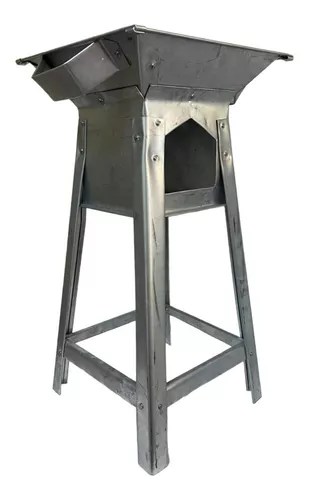

This set up was on Calle Donceles near the Hotel Catedral when I visited El D.F. in 2007
At first she sold sopes, gorditas and tlacoyos, but her gorditas were considered to be quite expensive. Each one cost 5 pesos, and if we consider that at the time one could eat a whole duck for only 10 pesos, she struggled as customers preferred to buy from other dealers. She persisted however. Carmelita did not lower her guard or her prices, her most loyal customers knew that they were paying for the delicious salsas that they could only try at that stand: a red guajillo chile salsa and a salsa verde of green cuaresmeño chiles.


The huarache was born as a special request for a market butcher who asked Doña Carmen to roast costillas and serve it on two of her gorditas. From there, Carmelita began to make the biggest gorditas. This proved cumbersome as the gorditas are quite small so she lengthened the size of her tlacoyos and used lard to fry the combination of corn and beans before adding the carne. She then named it “huarache” because of the similarity with traditional Mesoamerican footwear.
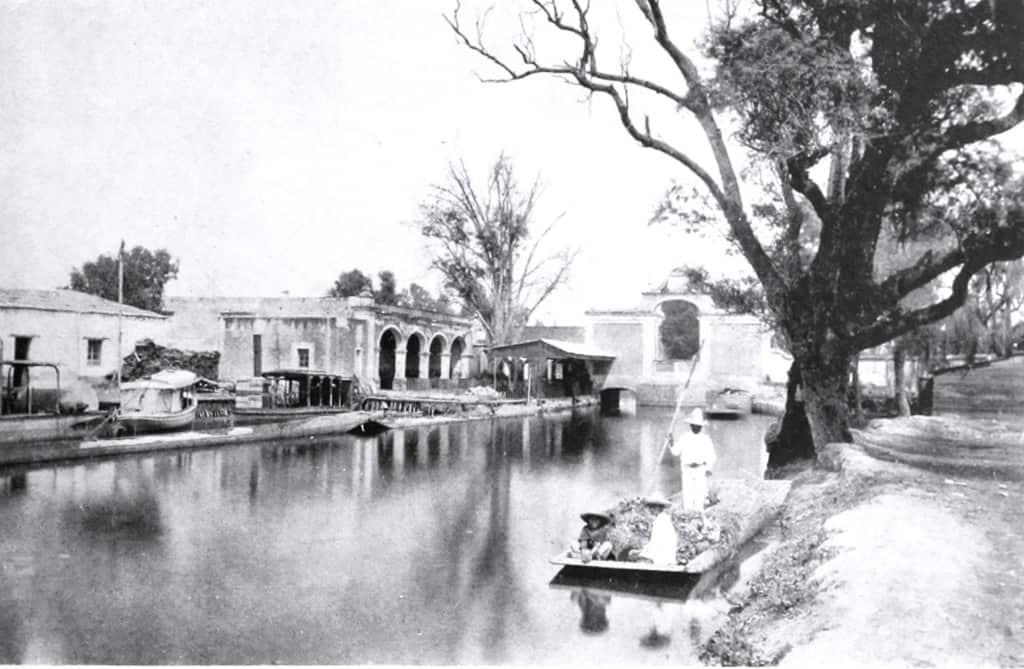

La calzada de La Viga (the La Viga road) is a road axis in Mexico City that runs from the center to the south of the city. It follows the route of the old La Viga canal which was once one of the most important canals in old Mexico-Tenochtitlan. The canal was used mainly for transporting agricultural products from the surrounding towns into the capital and an estimated 4,000 canoes made this journey every year. In 1607, Viceroy Don Luis de Velasco y Castile commissioned engineer Enrico Martínez with the task of draining the Mexico Valley basin. A number of canals from the time of the Mexica were retained and made into major routes for goods to arrive in the city. What became known as the Acequia Real, the Royal Canal, continued to connect Lake Xochimilco with the center of the city. After Independence, it became known officially as the National Canal, but commonly as La Viga. The canal, lined with trees on either side, remained a path from the country into what was by the early 20th century an increasingly urban environment. By 1921 the city government chose to pave over the canal with cement and asphalt and eventually tramlines were laid in to follow the path once cut by the canal. The disappearance of La Viga did not mean the end of its influence on the structure of the City. As the Canal was the route for supplying the City for over three hundred years, major markets were subsequently located near the old Canal. The huge Centro de Abastos, the city’s major wholesale market, is east of La Viga in the Delegacion of Iztapalapa. Near the northern end, just east of the Centro Histórico, is the huge retail Mercado de Merced. In between are the Mercado Jamaica, a flower market, and Mercado de Peces, the fish market. A portion of the original canal still exists. South of the highway Rio Churubusco, Calzada de la Viga becomes Avenida Canal Nacional, a divided roadway with the remaining waterway running up the middle.

The Mercado Jamaica can be seen in the top right corner of the image

Carmens legacy continues to this day


Carmelita’s five children continued her legacy. From the original location, the Huarache Azteca and the Huarache de Jamaica were born, both run by Doña Carmen’s descendants and which today are two unmissable stops if you are in the area.
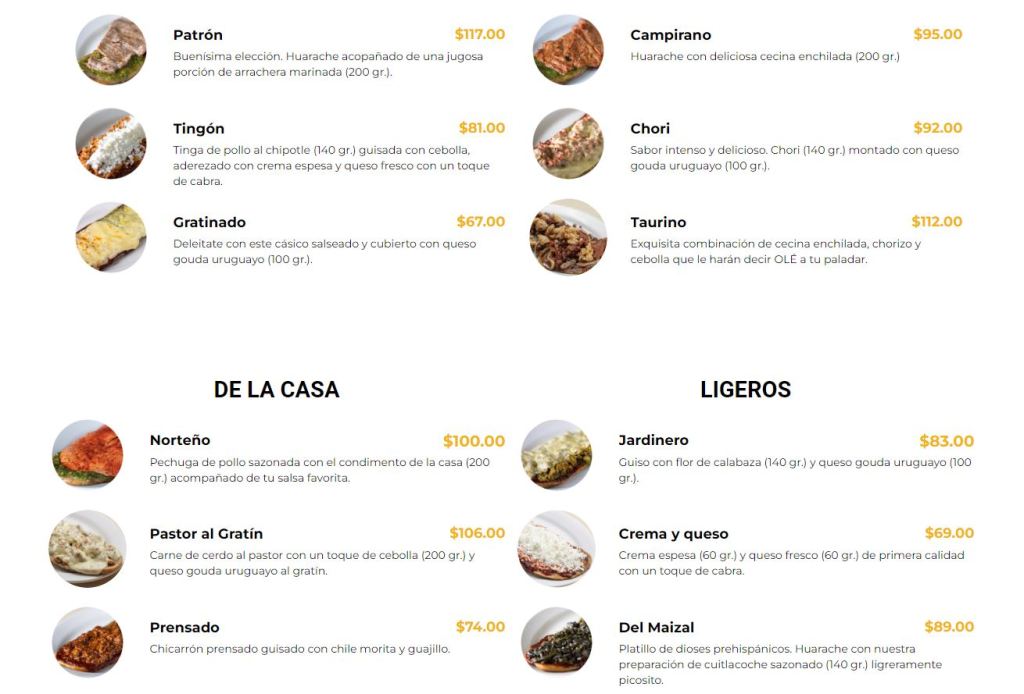
Now, let’s investigate the differences

A Oaxacan tlayuda will generally be made from white corn (1) whereas in Mexico City they’ll use maiz azul or blue corn.
- maiz blanco – which might also be called cacahuazintle or hominy (in the U.S.A)

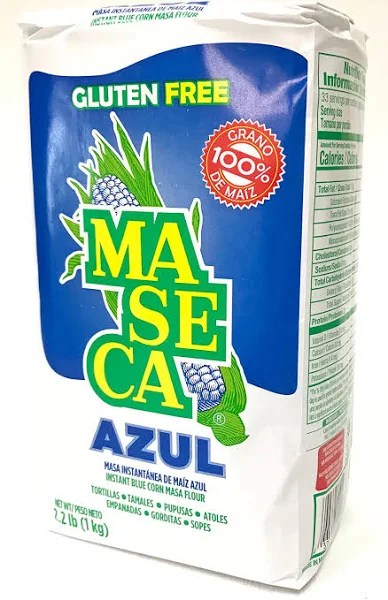
and, yes, it is quite blue. There is also an issue in México with corn being adulterated with blue colouring (1)
- LA Taco gives some guidelines for weeding out the fakes. https://lataco.com/how-to-tell-youre-eating-a-fake-blue-corn-tortilla-kernel-of-truth-organics-has-a-mission. Mexico Desconocido also provides a test you can use to see if your masa has been dyed..https://www.mexicodesconocido.com.mx/tortilla-de-maiz-azul-falsa.html?fbclid=IwZXh0bgNhZW0CMTEAAR2k4o3VOPVq0gwVzGwy4zbfK3y30a1__mpIciwR35ZeOTfHeCbdmGGGnTA_aem_AYa7mz03ozTZfDcjEoYq91djGwkETxsC92UbTA33OaT-MzGMfuEuEOVHFi10DKKvPOjXwHK_v1SK8CXTdSNcvBxh

In the CDMX the primary difference is in the maíz. Tortillas are made from nixtamalized corn which is dehydrated maíz kernels which have been cooked in an alkaline solution created by mixing cal (1) with water. This nixtamalized corn, when ground, creates masa which is the base of our Vitamina T. The masa can also be dried into a powder called masa harina (masa flour) which can simply be rehydrated and used. Now, when we look at the doradita as mentioned above it notes it as being made from maíz azul martajado. Martajado is the key word here (2). Where masa is quite finely ground (a little less finely for tamal dough), maíz martajado is roughly ground and has a grainy texture similar to that of polenta. Polenta (2) is a dish usually associated with Italy and is made from roughly ground un-nixtamalized corn and used to make a porridge/gruel like dish and is absolutely useless for making tortillas (3).
- Cal is calcium hydroxide (or slaked lime), sometimes wood ashes are used to create the liquid. Check my Post Nixtamal for more on this process. The liquid left over after the process is also quite interesting, check out Nejayote for more information on this.
- Cooking Technique : Martajar
- Although in India is is used to make a type of thick flat bread called Makki ki roti. Check out Aneesha’s recipe at https://spicecravings.com/makki-ki-roti-seasoned-cornmeal-flatbread


(also the CDMX)

Toluca has different opinions on the matter.
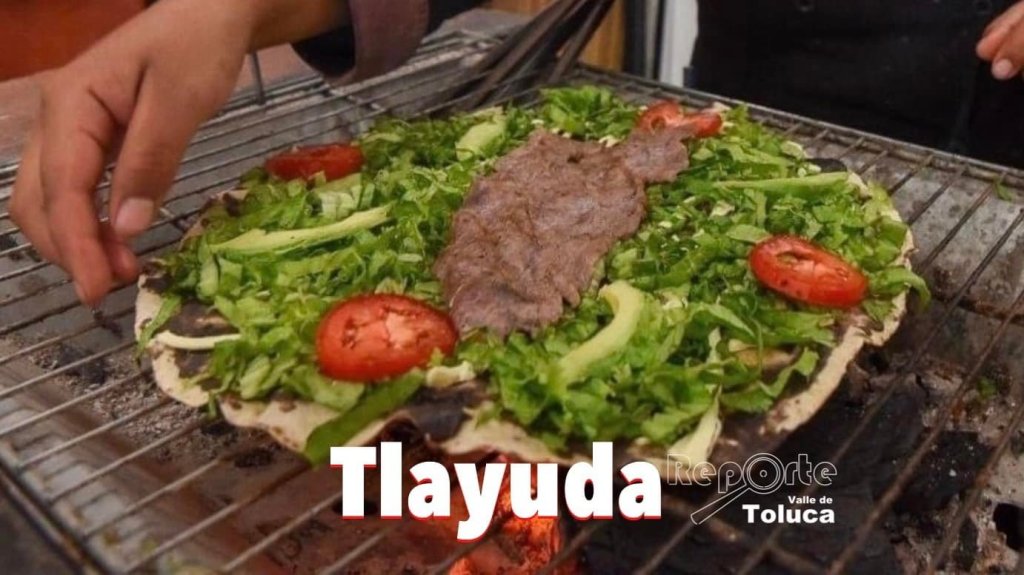

A Tolucan tlayuda is quite similar to that of Oaxaca, as is their huarache if we get down to it. Their huaraches are different to those in the CDMX and bear no resemblance to the sole of the shoe from where the name originates. Another difference is that a huarache might not just be a type of tortilla that is cooked and then covered with various toppings but that it might also have frijoles inside the tortilla itself (somewhat similar to a Salvadoran pupusa).


But then the doradita might also be called a tlayuda.


Or are they Tlacoyos?
Oh for fucks sake México!!!!

Lets not get bogged down in semantics.
Let us eat.
First, make your manteca.
Making your own (both manteca y asiento)
Homemade Lard (Manteca Hecha en casa) and Asiento.
This recipe involves rendering pork fat in two stages. Neither stage will give you the pristine white blocks seen earlier but you’ll be making something more akin to my fathers dripping. Please note that the pork fat must be fresh, not salted or smoked. Not all pork fat will produce asiento – try to get some with a little meat attached.
Cut 1300 grams (about 3 pounds) of fresh pork fat into 2.5cm cubes (about ½-inch). This can be a messy job that will be made easier if you freeze the fat for an hour or so before you start cutting.

For the first stage of the rendering process, place the diced pork fat in a large, deep roasting pan or shallow Dutch oven with thick sides. (I use a 12- by 3½-inch Dutch oven with a cover.) Make sure that the bits are somewhat separated, not all clumped together. Place on the stove over low heat and cook, uncovered, stirring often, for 20 to 30 minutes or as long as it takes for the fat to have partly rendered out and the diced pieces to be somewhat (not fully) crisp. Remove the pan from the heat and let cool slightly. Pour the contents of the pan into a tall, narrow container. Set aside the half-finished cracklings and any grainy residue (asiento). You will now have about 3 cups clear, pale tan lard and ¼ cup grainy residue. Refrigerate the lard until solid, cover tightly, and store up to a week in the refrigerator, or indefinitely in the freezer.

To proceed with the second stage of the rendering process, place the half-done cracklings in the same pan or in a large cast-iron skillet. Cook, covered, stirring occasionally, over low heat for another 20 to 30 minutes, or until the cracklings have yielded all their fat. Watch carefully toward the end, reducing the heat as low as possible to avoid scorching. Let cool and strain as instructed above. When the lard has cooled and settled, carefully transfer into another container and separate the sediment (asiento) that has collected on the bottom of the container. You will have about 3 to 3½ cups of crisp cracklings, another ⅓ cup of asiento, and 1 cup of a darker, more intensely flavored lard called manteca amarilla (“yellow lard”). Use this in cooking when you want an especially rich, nutty flavor. (In Oaxaca it is used to make a hearty-textured bread called pan amarillo.)
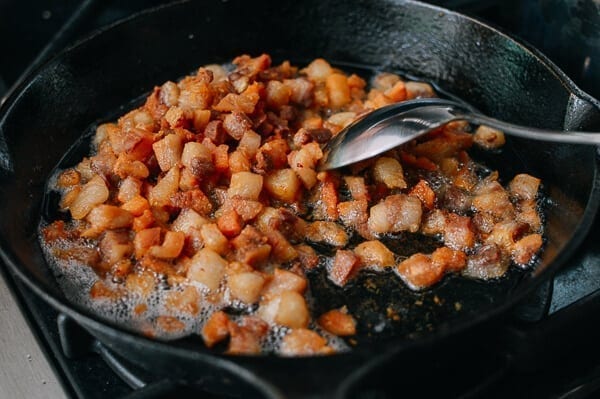
Add the second batch of asiento to the first and place in a tightly covered container. It will keep in the refrigerator for up to a week or the freezer for several months. The cracklings can be eaten out of hand (sprinkle with a little salt and powdered red chile, if desired) or ground in a mortar or food processor until barely crumbly (not a paste) (and use to fill tamales if you so desire). The crumbled asiento will keep up to a week in the refrigerator but are always best eaten fresh.
Or, if you want to bypass this longer process and make an “aciento” which is essentially a type of meat salsa used as a flavour base for your tlayuda then we could try Bricia Lopez’ hack.
Aciento (Pork Rind Paste) Bricia Lopez
I also understand that a lot of people may not have the time to properly render chicharrón into a paste, so this shortcut version using olive oil is much quicker and tastes almost as good. Think of this as a Oaxacan brown butter. If you do it right, it should taste nutty and toasty, not like lard or like fat.
If you can’t find or don’t have access to fresh chicharrón, American-style pork rinds also work well.
Ingredients
Makes 3 cups (720 mL)
13 ounces (375 g) chicharrón
3⁄4 cup (180 ml) olive oil
Step 1
Place the ingredients in a food processor and process until smooth and the chicharrón is broken down to a chunky paste, about 3 minutes.
Step 2
This aciento will keep in the refrigerator for a month.
Reprinted from Oaxaca: Home Cooking from the Heart of Mexico. (2019) by Bricia Lopez.
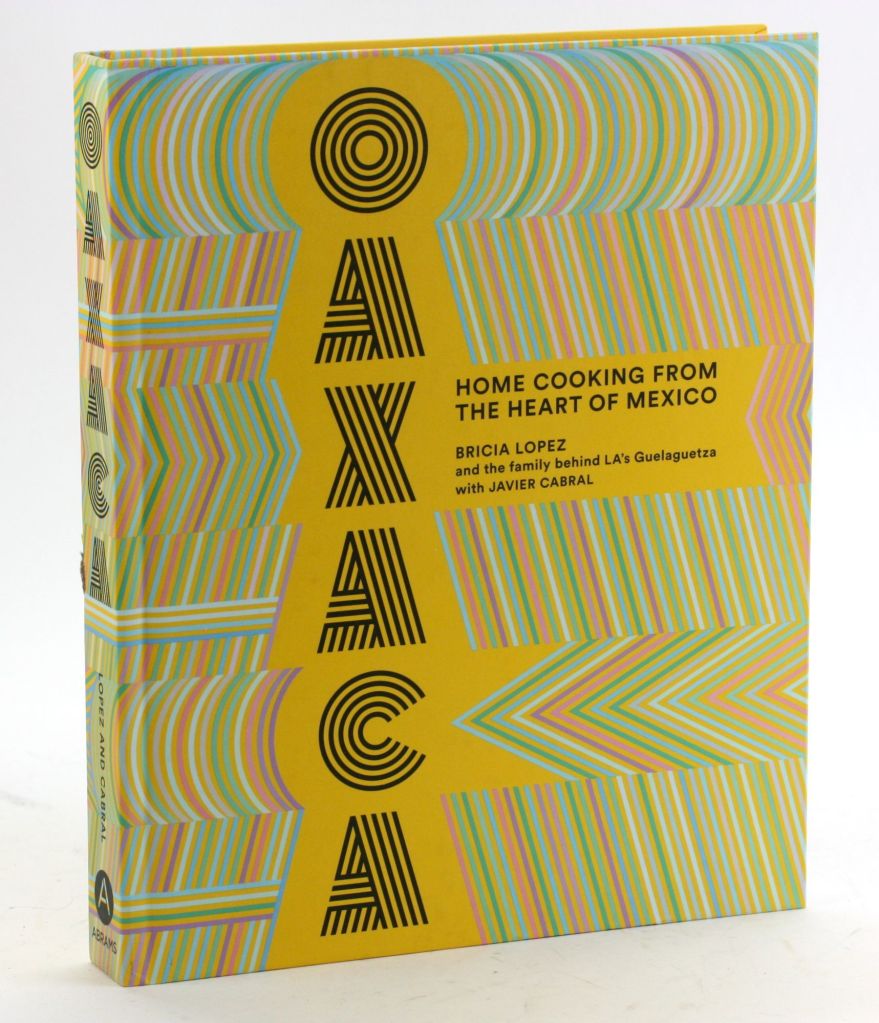
References
- Arias-Rico, José, Francisco Jesús Macías-León, Ernesto Alanís-García, Nelly del Socorro Cruz-Cansino, Osmar Antonio Jaramillo-Morales, Rosario Barrera-Gálvez, and Esther Ramírez-Moreno. 2020. “Study of Edible Plants: Effects of Boiling on Nutritional, Antioxidant, and Physicochemical Properties” Foods 9, no. 5: 599. https://doi.org/10.3390/foods9050599
- Dhaka V, Gulia N, Ahlawat KS, Khatkar BS. Trans fats-sources, health risks and alternative approach – A review. J Food Sci Technol. 2011 Oct;48(5):534-41. doi: 10.1007/s13197-010-0225-8. Epub 2011 Jan 28. PMID: 23572785; PMCID: PMC3551118.
- Dehghan M, Mente A, Zhang X, Swaminathan S, Li W, Mohan V, Iqbal R, Kumar R, Wentzel-Viljoen E, Rosengren A, Amma LI, Avezum A, Chifamba J, Diaz R, Khatib R, Lear S, Lopez-Jaramillo P, Liu X, Gupta R, Mohammadifard N, Gao N, Oguz A, Ramli AS, Seron P, Sun Y, Szuba A, Tsolekile L, Wielgosz A, Yusuf R, Hussein Yusufali A, Teo KK, Rangarajan S, Dagenais G, Bangdiwala SI, Islam S, Anand SS, Yusuf S; Prospective Urban Rural Epidemiology (PURE) study investigators. Associations of fats and carbohydrate intake with cardiovascular disease and mortality in 18 countries from five continents (PURE): a prospective cohort study. Lancet. 2017 Nov 4;390(10107):2050-2062. doi: 10.1016/S0140-6736(17)32252-3. Epub 2017 Aug 29. PMID: 28864332.
- Forouhi N G, Krauss R M, Taubes G, Willett W. (2018) Dietary fat and cardiometabolic health: evidence, controversies, and consensus for guidance BMJ 2018; 361 :k2139 doi:10.1136/bmj.k2139
- Fukalova Fukalova T, García-Martínez MD, Raigón MD. Nutritional Composition, Bioactive Compounds, and Volatiles Profile Characterization of Two Edible Undervalued Plants: Portulaca oleracea L. and Porophyllum ruderale (Jacq.) Cass. Plants (Basel). 2022 Jan 29;11(3):377. doi: 10.3390/plants11030377. PMID: 35161358; PMCID: PMC8839399.
- Ginter E, Simko V. New data on harmful effects of trans-fatty acids. Bratisl Lek Listy. 2016;117(5):251-3. doi: 10.4149/bll_2016_048. PMID: 27215959.
- Keys, Ancel. Seven Countries: A Multivariate Analysis of Death and Coronary Heart Disease, Cambridge, MA and London, England: Harvard University Press, 1980. https://doi.org/10.4159/harvard.9780674497887
- Mente A, O’Donnell M, Yusuf S. Sodium Intake and Health: What Should We Recommend Based on the Current Evidence? Nutrients. 2021 Sep 16;13(9):3232. doi: 10.3390/nu13093232. PMID: 34579105; PMCID: PMC8468043.
- Petrov AM, Kasimov MR, Zefirov AL. Brain Cholesterol Metabolism and Its Defects: Linkage to Neurodegenerative Diseases and Synaptic Dysfunction. Acta Naturae. 2016 Jan-Mar;8(1):58-73. PMID: 27099785; PMCID: PMC4837572.
- Pipoyan D, Stepanyan S, Stepanyan S, Beglaryan M, Costantini L, Molinari R, Merendino N. The Effect of Trans Fatty Acids on Human Health: Regulation and Consumption Patterns. Foods. 2021 Oct 14;10(10):2452. doi: 10.3390/foods10102452. PMID: 34681504; PMCID: PMC8535577.
- Pirahanchi Y, Sinawe H, Dimri M. Biochemistry, LDL Cholesterol. [Updated 2023 Aug 8]. In: StatPearls [Internet]. Treasure Island (FL): StatPearls Publishing; 2024
- Ramkumar S, Raghunath A, Raghunath S. Statin Therapy: Review of Safety and Potential Side Effects. Acta Cardiol Sin. 2016 Nov;32(6):631-639. doi: 10.6515/acs20160611a. PMID: 27899849; PMCID: PMC5126440.
- Sacks FM, Lichtenstein AH, Wu JHY, Appel LJ, Creager MA, Kris-Etherton PM, Miller M, Rimm EB, Rudel LL, Robinson JG, Stone NJ, Van Horn LV; American Heart Association. Dietary Fats and Cardiovascular Disease: A Presidential Advisory From the American Heart Association. Circulation. 2017 Jul 18;136(3):e1-e23. doi: 10.1161/CIR.0000000000000510. Epub 2017 Jun 15. Erratum in: Circulation. 2017 Sep 5;136(10 ):e195. PMID: 28620111.
Sterols and Stanols Research (this is only a very small amount of the information available. Hundreds of studies have been conducted on this subject – not all are positive though)
- AbuMweis SS, Vanstone CA, Lichtenstein AH, Jones PJ. Plant sterol consumption frequency affects plasma lipid levels and cholesterol kinetics in humans. Eur J Clin Nutr 2009; 63(6): 747-755
- Hernández-Mijares A, Bañuls C, Rocha M, Morillas C, Martínez-Triguero ML, Víctor VM, Lacomba R, Alegría A, Barberá R, Farré R and Lagarda MJ. Effects of phytosterol ester-enriched low-fat milk on serum lipoprotein profile in mildly hypercholsterolaemic patients are not related to dietary cholesterol or saturated fat intake. Br J Nutr 2010; 104(7): 1018-1025
- Houweling AH, Vanstone CA, Trautwein EA, Duchateau GS, Jones PJ. Baseline plasma plant sterol concentrations do not predict changes in serum lipids, C-reactive protein (CRP) and plasma plant sterols following intake of a plant sterolenriched food. Eur J Clin Nutr 2009; 63(4): 543-551.
- Jenkins DJ, Kendall CW, Nguyen TH, Marchie A, Faulkner DA, Ireland C, Josse AR, Vidgen E, Trautwein EA, Lapsley KG, Holmes C, Josse RG, Leiter LA, Connelly PW, Singer W. Effect of plant sterols in combination with other cholesterol lowering foods. Metab Clin Exp 2008; 57(1): 130-139.
- Jenkins DJ, Kendall CW, Faulkner D, Vidgen E, Trautwein EA, Parker TL, Marchie A, Koumbridis G, Lapsley KG, Josse RG, Leiter LA, Connelly PW. A dietary portfolio approach to cholesterol reduction: combined effects of plant sterols, vegetable proteins, and viscous fibers in hypercholesterolemia. Metabolism 2002; 51(12): 1596-1604.
- Jones PJ, Raeini-Sarjaz M, Ntanios FY, Vanstone CA, Feng JY, Parsons WE. Modulation of plasma lipid levels and cholesterol kinetics by phytosterol versus phytostanol esters. J Lipid Res 2000; 4(5): 697-705.
- Jong de A, Plat J, Lütjohann D, Mensink RP. Effects of long-term plant sterol or stanol ester consumption on lipid and lipoprotein metabolism in subjects on statin treatment. Br J Nutr 2008; 100(5): 937-941
- Judd JT, Baer DJ, Chen SC, Clevidence BA, Muesing RA, Kramer M, Meijer GW. Plant sterol esters lower plasma lipids and most carotenoids in mildly hypercholesterolemic adults. Lipids 2002; 37(1): 33-42
- Lottenberg AM, Nunes VS, Nakandakare ER, Neves M, Bernik M, dos Santos JE, Quintao EC. Food phytosterol ester efficiency on the plasma lipid reduction in moderate hypercholesterolemic subjects. Arq Bras Cardiol 2002; 79(2): 139-142.
- Normén L, Ellegard L, Janssen HG, Steenbergen H, Trautwein E, Andersson H. Phytosterol and phytostanol esters are effectively hydrolysed in the gut and do not affect fat digestion in ileostomy subjects. Eur J Nutr 2006; 45(3): 165-170.
- Ntanios FY, Homma Y, Ushiro S. A spread enriched with plant sterol-esters lowers blood cholesterol and lipoproteins without affecting vitamins A and E in normal and hypercholesterolemic Japanese men and women. J Nutr 2002; 132(12): 3650-3655.
- Sialvera TE, Koutelidakis AE, Richter DJ, Yfanti G, Kapsokefalou M, Micha R, Goumas G, Diamantopoulos E, Zampelas A. Phytosterol supplementation does not affect plasma antioxidant capacity in patients with metabolic syndrome. Int J Food Sci Nutr 2013; 64(1): 21-27.
- Trautwein EA, Duchateau GSMJ, Lin YG, Mel’nikov SM, Molhuizen HOF, Ntanios FY. Proposed mechanisms of cholesterol-lowering action of plant sterols. Eur J Lipid Sci Technol 2003; 105(3-4): 171-185.
Websites
- https://dle.rae.es/asentar
- https://dle.rae.es/asiento?m=form
- Carmen Gómez Medina: inventora del huarache en 1935 : https://www.local.mx/restaurantes/comida-callejera/huaraches/
- Carmelita, la mujer que sin saber hacer tortillas inventó el huarache : https://www.eluniversal.com.mx/entrada-de-opinion/colaboracion/mochilazo-en-el-tiempo/nacion/sociedad/2016/12/7/carmelita-la-mujer/
- Carmelita Medina, the woman who invented huaraches : https://www.mexicodesconocido.com.mx/carmelita-medina-la-mujer-que-invento-los-huaraches.html?fbclid=IwZXh0bgNhZW0CMTEAAR3Njl_jLN671rfvLEzKf6F270DwzPWO-xRXaY3AcHZkcwyQG9UOBnW2egU_aem_AVUasJnqxNUR0pb6EeDemH5K0JhEDrSA9RICA8ebEp2pERQNhWrQ9HHsDdCua2CksraIb6QBQPX-f1MMW41uk7DD
- Good Lard, Bad Lard: What Do You Get When You Cross a Pig and a Coconut : https://www.westonaprice.org/good-lard-bad-lard-what-do-you-get-when-you-cross-a-pig-and-a-coconut/?_ga=2.268082830.1833851596.1692346743-1342798632.1692346743#gsc.tab=0
- High calories but not fat content of lard-based diet contribute to impaired mitochondrial oxidative phosphorylation : https://journals.plos.org/plosone/article?id=10.1371/journal.pone.0217045
- Mexico City’s Canals : Calzada de la Viga : https://en.mxcity.mx/2016/06/canals-calzada-de-la-viga/
- Saturated Fats and Health: A Reassessment and Proposal for Food-Based Recommendations : https://www.sciencedirect.com/science/article/pii/S0735109720356874
Images
- Asiento-oaxaca : https://gourmetdemexico.com.mx/gourmet/cultura/asiento-grasa-cerdo-antojitos-oaxaca/
Asiento # 2 : D_NQ_NP_890761-MLM51456584162_092022-O : https://articulo.mercadolibre.com.mx/MLM-779139702-asiento-de-cerdo-5-kg-para-tlayudas-o-memelas-oaxaqueno-100-_JM - Asientos y manteca de Puerco via El Kuino on FB : https://www.facebook.com/1494111354188524/posts/asientos-y-manteca-de-puerco-lo-encuentras-en-carnitas-el-kuino-que-rica-tiene-l/2148238218775831/
- Huaraches at the Mercado de Abastos in Oaxaca – https://huaracheblog.wordpress.com/2012/11/06/huaraches-in-the-mercado-de-abastos-oaxaca/
- Huaraches gigantes : Photo: Eduardo Montoya. : https://www.chilango.com/comida/tacos-arenal-huaraches-gigantes-de-la-cdmx/
- Lard from my Mexican butcher : image by Boar-On-The-Floor via Reddit : https://i.imgur.com/HZ0bDxH.jpg
- las-tlayudas-oaxaca-vs-cdmx : https://mesaysazon.com/las-tlayudas-oaxaca-vs-cdmx/
- Memelas de asientos de puerco via La cocina es un arte on Facebook – https://www.facebook.com/234452500015679/photos/memelas-de-asientos-de-puerco-o-resingredientes200-gr-de-masa-de-ma%C3%ADz20-gr-frijo/628441023950156/?paipv=0&eav=AfYmWOqiKz6kCViIAceglEQJDx72pJyHsgb_BSkeHPVxNfaykm9lCgB1OgWdKlCB6p0&_rdr
- Plain tlayuda : https://articulo.mercadolibre.com.mx/MLM-612620340-asiento-de-puerco-para-tlayudas-oaxaquenas-1-kg-envio-gr-_JM
- Sinaloa style gorditas con asiento – via Arriba Culiacán on Facebook : https://www.facebook.com/ArribaCuliacan/posts/gorditas-con-asientos-estilo-sinaloa/10155546713337819/
- Tamales de asientos de Chicharrón via El Sazón de Julio on YouTube – https://www.youtube.com/watch?v=n8hYpJXhUrk
- Tlayuda y chepiche : https://aderezo.mx/sabores_urbanos/la-tlayuda-ya-es-la-mas-famosa-en-redes-sociales/
- Tlayuda 1 : https://www.facebook.com/revistagourmetdemexico/photos/existe-cierta-confusi%C3%B3n-entre-las-tlayudas-de-oaxaca-y-las-doraditas-que-venden-/3641826899215274/
- ¿Tlayudas o doraditas? – Capitalinos MX : https://www.facebook.com/photo/?fbid=850746360411591&set=a.585540326932197
- Tortillas de asiento – https://decabezarestaurant.com/product/tortillas-con-asientos/

